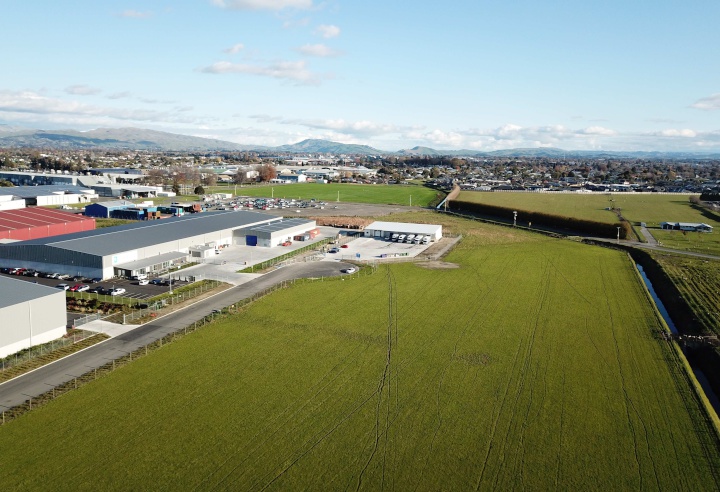July 11, 2018

A large site
next door to Heinz Wattie’s’ big production plant in
Hastings is aiming to become Hawke’s Bay’s new home for
food industry production and development.
The 16.5 ha Tomoana Food Hub is offering design, build and lease options to food-related businesses of any size.
“Up to 9.7 hectares of land is currently available for the development of modern food grade premises for the processing and manufacturing of food and beverage products on attractive, flexible lease terms,” says Daniel Moffit, Bayleys Havelock North and Hastings branch manager.
“Businesses servicing the food and beverage sector, such as storage, packaging, distribution or transport companies, as well as research facilities, can also be accommodated.”
Moffit and Jake Smith of Bayleys Havelock North office have been appointed sole leasing agents for Tomoana Food Hub being developed by a long established Hawke’s Bay business, owned by the Taylor family, which also operates Tomoana Warehousing and Transport.
Development manager Logan Taylor says the hub can host any business operating within the food industry. “We are developing much more than an industrial business park,” he says. “We are creating a collaborative workspace for food and beverage businesses to cluster and share knowledge, by-products, energy, logistics and infrastructure, resulting in increased productivity and profitability.
“Our specific zoning only allows businesses in the food value chain, which means neighbours are always going to be other complementary food businesses – there’ll be no heavy industrial activity, which is important from a food safety and market perception angle.”
Taylor says individual tenant needs are catered for in a flexible approach which allows them to grow without tying up large amounts of capital in land and buildings. On-site third party logistics and overflow storage services will enable occupants to focus on their core businesses without additional administration and accommodation concerns.
“We’re keen to encourage collaboration and innovation whereby both small start-ups and large multinational businesses can co-locate at the hub and focus on adding value, while creating strong brands that can take on global markets.”
A number of companies have already come on board at the Tomoana Food Hub. Australasia’s largest supplier of food cans Jamestrong has established a new 7,500m² tin-plate coating plant building on two hectares of land close to its existing can forming plant in Hastings and large customer, Kraft Heinz.
The building was designed and built around their key plant requirements, including a machine in excess of 85-metres long, to maximise manufacturing efficiencies with a specialist foundation design to support heavy loads.
New Zealand Miracle Water has established a state-of-the art 9,500m² food grade aseptic manufacturing facility on a 2.5 hectare site at the Tomoana Food Hub to produce packaged water products mostly for export. The company is tapping into pure artesian water located directly underground in the Heretaunga confined aquifer through a new bore.
Other occupants include multinational pallet and container pooling services company CHEP, Tomoana Warehousing and Fonterra, a recent addition.
A site of this scale is rare in the Hawke’s Bay area, particularly with the multiple infrastructure benefits that are on offer, says Daniel Moffit. These include roading designed for heavy vehicles, power and high pressure gas capacity to cater for high energy users and a council reticulated trade waste system that runs directly through the site allowing easy and cheap connections to discharge waste. Moffit says trade waste discharge costs per litre in Hastings are 20 times cheaper than Auckland.
Individual bores on each lot also supply water for amenities, fire protection and processing/manufacturing. “The Heretaunga artesian aquifer is a pristine source of fresh water offering a natural asset that is unrivalled anywhere in the country and which provides significant competitive advantage for food and beverage producing occupants,” says Moffit.
He says Tomoana Food Hub is also close to reliable and easily accessible transport links. Arterial highways heading north and south are minutes away and Napier port and airport are within 20 kilometres, allowing national and international exporters to move produce efficiently and cost effectively.
“Hastings Council is also committed to supporting the success and further development of Tomoana Food Hub,” says Moffit. “Every possible assistance is given to companies wishing to relocate here.”
ends



 John Mazenier: Gaffer Tape And Glue Delivering New Zealand’s Mission Critical Services
John Mazenier: Gaffer Tape And Glue Delivering New Zealand’s Mission Critical Services Earthquake Commission: Ivan Skinner Award Winner Inspired By Real-life Earthquake Experience
Earthquake Commission: Ivan Skinner Award Winner Inspired By Real-life Earthquake Experience Reserve Bank: Consultation Opens On A Digital Currency For New Zealand
Reserve Bank: Consultation Opens On A Digital Currency For New Zealand NIWA: Ship Anchors May Cause Extensive And Long-lasting Damage To The Seafloor, According To New Research
NIWA: Ship Anchors May Cause Extensive And Long-lasting Damage To The Seafloor, According To New Research New Zealand Customs Service: A Step Forward For Simpler Trade Between New Zealand And Singapore
New Zealand Customs Service: A Step Forward For Simpler Trade Between New Zealand And Singapore Horizon Research: 68% Say Make Banks Offer Fraud Protection
Horizon Research: 68% Say Make Banks Offer Fraud Protection



